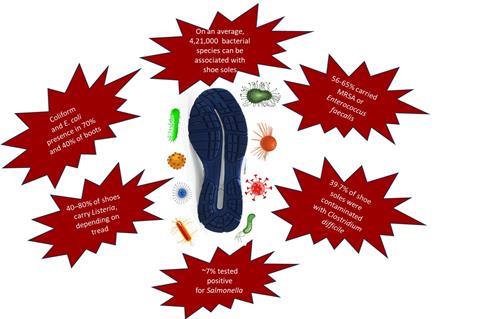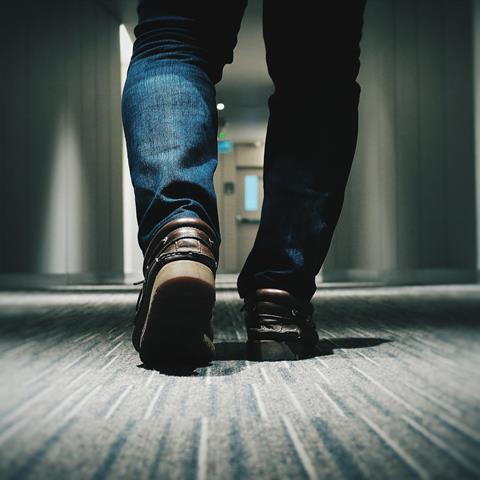Airports serve as vibrant epicentres of human activity, facilitating the global exchange of people, ideas, and cultures. Over 4 billion passengers pass through airports every year, along with millions of tons of cargo. However, airports are not only centres for travel and trade; beneath their sleek surfaces and smooth operations lies a frequently overlooked health risk, the invisible pathways of microbial transmission.
Pathogen-laden surfaces facilitate infections, including respiratory, gastrointestinal, dermatological, and systemic conditions like sepsis.Tinea pedis, the most contagious fungal infection, spreads via contaminated surfaces such as carpets, and damp floors, with spores persisting in high-foot-traffic areas.
One such often-underestimated vector for disease transmission is footwear. Emerging research underscores a disturbing reality: shoes, often seen merely as vessels for comfort and fashion, are potent carriers of harmful microorganisms. These pathogens pose a significant public health threat, particularly in high-traffic environments. This makes airports particularly susceptible to microbial exchange. As travellers journey across regions and continents, their shoes come into contact with a myriad of surfaces, from restrooms to security checkpoints, each step harbouring the potential to transfer pathogens. The practice of shoe removal and use of the same tray for carrying shoes and personal belongings at airport security check-ins further exacerbates this issue, introducing additional risks of cross-contamination as passengers interact with shared surfaces.
Many microbes can survive on both the interior and exterior of shoes for up to five days. Given that shoes are typically constructed from materials such as leather, rubber, and plastic, they can act as conduits for pathogenic agents, and in some cases, serve as breeding grounds for bacteria and viruses. This is further compounded by the fact that shoes are in frequent contact with soil and dirt, which are teeming with microorganisms and provide easy access to nutrients. To illustrate, a single gram of soil may contain up to 10 billion microorganisms, encompassing a broad spectrum of species. Within that gram, one can find as many as 1010 bacterial cells, representing a staggering diversity of between 4,000 and 50,000 species. Such a rich microbial ecosystem, combined with the daily friction of shoes against contaminated surfaces, positions airports as microcosms of potential microbial exchange.
“Should we be seriously concerned about the role of footwear in pathogen transmission, and what steps can we take to minimize potential risks?”
Pathogen contamination on footwear: transmission dynamics
Shoe soles have been identified as significant carriers of a variety of pathogens, including Methicillin-resistant Staphylococcus aureus (MRSA), Clostridium difficile, and multidrug-resistant Gram-negative bacteria. These microorganisms are often transferred from the soles of shoes to environmental surfaces and objects, which can facilitate the spread of infections. Various studies have highlighted the role of environmental surfaces and fomites in the transmission of these pathogens, with contaminated footwear acting as a key vector.
Research indicates that bacterial particles can be released into the air when individuals walk on contaminated floors, contributing to airborne bacterial contamination. In fact, walking on these surfaces can account for up to 15% of airborne bacterial dispersal, which is notably more efficient than mopping or sweeping. Recent studies have shown that footwear in community environments can carry a significant microbial load. For instance, up to 40% of shoes in these settings were found to harbour toxigenic Clostridium difficile, while Listeria monocytogenes was detected in 40-80% of shoes worn by patrons of various facilities.
Interestingly, contamination rates were consistent across different shoe types, such as winter boots, hiking boots, and sports shoes. However, shoes with deeper treads exhibited higher levels of contamination compared to those with smoother soles. This suggests that the design and tread depth of shoes may influence the number of pathogens they collect from contaminated surfaces.
In addition to these bacteria, several other microorganisms have been identified on shoe soles. Salmonella species, known for causing foodborne illnesses, have been found on footwear, along with various types of Gram-positive cocci, such as Staphylococcus, which were present on leather, plastic, rubber, and athletic shoes. Leather shoes also showed contamination by Gram-positive, spore-forming rods typical of Bacillus. Gram-negative rods have been found on almost all footwear types, with the exception of plastic shoes.

Fungal contamination is also widespread, particularly as it is documented that a relative humidity of 96–100% inside footwear substantially contributes to bacterial growth and colonization of yeast-like fungi. The fungus Aspergillus was detected on all shoe types, with A. niger commonly found on rubber sandals and canvas shoes, and A. flavus on canvas and athletic shoes. Additionally, Penicillium species have been isolated from plastic, canvas, and athletic footwear, while species of Helminthosporium have been found predominantly on athletic shoes.
The microbial communities found on shoes vary significantly depending on the material of the footwear, the individual wearing them, and the geographic location of the study. These factors influence the types and abundance of microorganisms present, underlining the complex nature of microbial contamination associated with footwear. Furthermore, studies consistently show that walking on contaminated surfaces is a more effective method for dispersing bacteria into the air than traditional cleaning methods like mopping or sweeping. This highlights the importance of understanding and mitigating the role of shoes in the transmission of infectious agents.
Steps towards developing robust automated footwear decontamination strategies
The first step is recognizing footwear as a significant vector for pathogen transfer, which cannot be overstated. Hence, a revaluation of hygiene practices and protocols in these global transit hubs is of pivotal significance. To effectively mitigate the risks of microbial contamination from footwear, a multi-faceted approach is essential. These include:
- A standardized decontamination protocol should include brushing the soles, wiping with disinfectants like Virkon, and drying with paper towels.
- Regular floor sanitization every four hours, especially in high-traffic areas like entryways, is crucial.
- The use of antimicrobial mats at key entrances, including restrooms and food hubs can significantly reduce bacterial load, with tank-type mats proving most effective.
- Foot covers and disinfectant swabs should be provided at security checkpoints, allowing passengers to sanitize their shoes while placing them on disinfected conveyor systems.
- Additionally, boot baths utilizing disinfectants like UV exposure, chlorine-based solutions, and alcohol can further enhance pathogen control. Implementing these strategies will significantly reduce the risk of pathogen transmission via footwear in airport environments.
The foot microbiome is integral to its functioning; therefore, it needs to be emphasized that footwear microclimate should facilitate and maintain a balance of beneficial vs pathogenic/harmful microbial colonization and proliferation. This can be facilitated by detailed research investigations, and surveys that incorporate the modern advances in digital tools and include artificial intelligence to enable real-time and adaptive microbial surveillance and contamination control on footwear at airports. A system involving instantaneous and dynamic real-time pathogen detection, analytics for forecasting/early prediction, and robotic/autonomous disinfection systems, would ideally empower global surveillance, and biosecurity and minimize the outbreak of epidemics.
Further reading
Bacterial communities associated with cell phones and shoes - PMC
Forensic analysis of the microbiome of phones and shoes | Microbiome








No comments yet